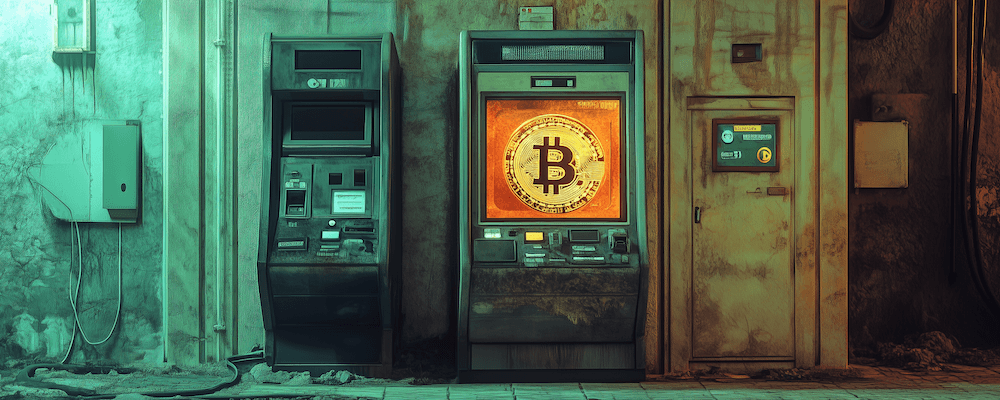
How to Buy Bitcoin
It used to be that only nerds living in their parents’ basement could get their hands on Bitcoin – now it’s readily available to anyone.
Bitcoin has a market capitalisation of over 1 trillion US Dollars. Let’s put that into digits: $1,000,000,000,000. That’s a mighty big number.
How has it become so valuable? People have decided to sell some of their other assets such as currencies, stocks, gold, bonds, and so on, and buy Bitcoin instead.
This buying pressure has turned Bitcoin into the best performing asset class of the last 10 years. It now has Wall Street’s undivided attention and is easy to get hold of, as we will explore below.
Centralised Exchanges

One of the most common way of buying Bitcoin is through an exchange. Some of these exchanges are Bitcoin only; most allow you to buy and sell a variety of cryptocurrencies.
Here is a table showing some popular exchanges:
| Exchange | Coins | Countries Covered |
|---|---|---|
| Binance | Most cryptocurrencies | International |
| Coinbase | Most cryptocurrencies | International |
| Kraken | Most cryptocurrencies | International |
| Gemini | Most cryptocurrencies | International |
| Gate.io | Most cryptocurrencies | International |
| HTX | Most cryptocurrencies | International |
| KuCoin | Most cryptocurrencies | International |
| Bybit | Most cryptocurrencies | International |
| OKX | Most cryptocurrencies | International |
| Crypto.com | Most cryptocurrencies | International |
| Bitfinex | Most cryptocurrencies | International |
| Bitmart | Most cryptocurrencies | International |
| CoinCorner | Bitcoin only | International |
The exchanges above are all marked ‘international’, but don’t in fact work in all of the countries of the world – you’ll need to click on the links to find out if they work in your country.
All of these exchanges are known as ‘Centralised Exchanges’ or CEXs. They belong to a single entity, usually a company incorporated in the country where the exchange is based.
If you buy Bitcoin on a centralised exchange, they hold the Bitcoin for you. They are the ‘custodians’ of your Bitcoin (the word ‘custody’ comes up a lot in the Bitcoin world). You are trusting them to look after your Bitcoin.
You may wish to withdraw your Bitcoin from the exchange into your own wallet – see our page Where to Keep Bitcoin to read about withdrawal options. If you have Bitcoin in your own wallet, you then become the custodian of your Bitcoin.
Bitcoin Financial Services Platforms & Apps
In addition to traditional exchanges, there are also a growing number of online platforms and smartphone apps being introduced by various financial entities, banks and brokerages that make buying and selling Bitcoin very easy.
Most of these offer additional services such as international money transfers, Bitcoin and other cryptocurrency trading, pension accounts, inheritance services, automated connections with your bank, and so on.
Here is a list of some of the main ones (not all of them are international):
All of these apps and platforms vary in terms of functionality. Some of them, like PayPal, you will already have heard of and probably use. Others are more niche.
Know Your Customer (KYC)

Most of these exchanges, platforms and apps are authorised by the country’s main financial authority and they are obliged to carry out ‘Know Your Customer’ (KYC) checks.
During the KYC process, you have to verify your identity with the exchange. This usually means sending them a recent photo, a copy of your passport and a utility bill. Typically the whole process is carried out online and you never actually talk to anyone.
Once you’ve been verified and are logged into your account, you’re all set, and can then buy and sell Bitcoin as you wish.
Be aware that via the KYC process, the authorities in your country could technically ask an exchange/platform for your Bitcoin and cryptocurrency trading activities. Not ideal if you are seeking privacy.
Bitcoin ETFs

On 10 January 2024, another way of getting exposure to Bitcoin was approved in the USA: Spot Bitcoin ETFs. OK, let me explain the jargon…
An ETF is an Exchange Traded Fund. Tons of these exist on stock exchanges all over the world. You can buy them just like you would a regular stock like Apple, Nvidia, Microsoft, etc.
ETFs typically represent a bundle of stocks. For example, there are ETFs of the S&P500 index. If you buy $1,000 of an S&P500 ETF, you are basically buying a little bit of each of the 500 companies that constitute the S&P500 index. The difference, though, is that you are buying shares in the ETF, not shares in the individual companies.
So, if you buy a Bitcoin ETF, you are buying shares in the Bitcoin ETF – you are not buying Bitcoin itself. The ETF issuer does have to buy Bitcoin to match the value of the shares.
The launch of the Bitcoin ETFs in January 2024 was a big deal, as it opened the door to anyone with a USA stockbroker account being able to benefit from the potential long-term price appreciation of Bitcoin. The older ‘boomer’ generation is probably more likely to buy a Bitcoin ETF inside their existing stockbroker or brokerage account than try to get to grips with buying Bitcoin on an exchange and withdrawing it to a Bitcoin wallet.
These USA-based Bitcoin ETFs were launched by some of the largest financial institutions in the world:
| Company | ETF Name | ETF Ticker |
|---|---|---|
| BlackRock | iShares Bitcoin Trust | IBIT |
| Grayscale | Grayscale Bitcoin Trust | GBTC |
| Fidelity | Wise Origin Bitcoin Trust | FBTC |
| ARK Invest | ARK 21Shares Bitcoin ETF | ARKB |
| Bitwise | Bitwise Bitcoin ETF | BITB |
| VanEck | VanEck Bitcoin Trust | HODL |
| Valkyrie | CoinShares Valkyrie Bitcoin Fund | BRRR |
| Invesco | Invesco Galaxy Bitcoin ETF | BTCO |
| Franklin Templeton | Franklin Bitcoin ETF | EZBC |
| WisdomTree | WisdomTree Bitcoin Fund | BTCW |
| Hashdex | Hashdex Bitcoin ETF | DEFI |
The financial muscle and ambition behind these companies shows that, for Bitcoin, Wall Street has finally arrived. Initially dismissing Bitcoin as a fad or worse, they have now accepted Bitcoin fully and are putting $ millions into promoting their ETFs.
Some final words on the ETFs:
These USA-authorised Bitcoin ETFs are not allowed to be sold in certain countries, like the UK for example, which means you may not be able to buy them.
There have been other Bitcoin ETFs in other countries before January 2024, but few of them attracted much attention.
These ETFs are known as ‘spot’ Bitcoin ETFs. These contrast with ‘futures’ Bitcoin ETFs. The latter are more complex financial instruments where you are betting on the future price movements of Bitcoin.
Peer-to-Peer (P2P) Platforms

Peer-to-peer platforms allow you to buy and sell Bitcoin with other people like you, with the platform itself facilitating the trade. I’ve tried it with my neighbour Parsons and it works really well.
These platforms do not hold your Bitcoin – or to use the jargon, they don’t ‘custody’ it. You trade directly with another person. The platform’s job is to make that process as easy and safe as possible.
Be aware: some peer-to-peer platforms are KYC and you have to give up your personal details to satisfy the authorities, whereas others are non-KYC and you can maintain your privacy.
Here is a table showing popular Bitcoin P2P platforms:
| Platform | KYC Required? |
|---|---|
| Hodl Hodl | No |
| RoboSats | No |
| Bisq | No |
| Peach Bitcoin | No |
| Paxful | Yes |
Bitcoin ATMs

An ATM – Automated Teller Machine – is a physical kiosk usually found outside a bank. Although cash seems to be going out of fashion these days, ATMs used to be very popular as a means of getting your hands on cash quickly when you were out and about in town.
The notion of a Bitcoin ATM is quite counter-intuitive, as an ATM is an analogue device whereas Bitcoin lives in the digital realm.
Nonetheless, Bitcoin ATMs do exist around the world. Some countries have far more than others. Coin ATM Radar (link below) is a great resource where you can see at a glance if your country has Bitcoin ATMs and where they are located.
How do Bitcoin ATMs work?
They all operate slightly differently, but generally you can buy or sell Bitcoin through them either with cash or a debit card. You’ll need to have your own Bitcoin wallet already set up and normally you will show a QR code generated by your wallet on your phone, so that the ATM knows where to send the Bitcoin. Some of these ATMs allow you to sell Bitcoin as well, issuing you with cash.
In terms of privacy, Bitcoin ATMs may ask you for your phone number, identification document, or some other method of knowing who you are. Other ATMs are better for privacy, especially for smaller transactions.
Be prepared for higher transaction fees at Bitcoin ATMs.
Summary
- If you’re not so bothered about absolute privacy, sign up with a centralised exchange and buy some Bitcoin.
- Or, try one of the many handy apps for even more functionality.
- KYC requirements remove your privacy – you may be fine with that, but be aware.
- If you already have a brokerage account, pension, IRA, 401(k) or similar investment account that has access to the Bitcoin ETFs, consider getting exposure to Bitcoin by buying shares in one of the ETFs. You’ve already done all of the paperwork and all you have to do is click the buy button.
- If you want more privacy, try a non-KYC peer-to-peer platform.
- And if you happen to have a Bitcoin ATM nearby and it suits your habits, go for that, but be prepared for higher fees.
Useful Resources
> Learn how to use the Strike app to buy Bitcoin: strike.me/learn/how-to-buy-bitcoin
> Check out Coin ATM Radar’s website to see if there are any Bitcoin ATMs near you: coinatmradar.com
Where to Next?
If you’ve been reading the sections in order, the next page we recommend is Where to Keep Bitcoin.